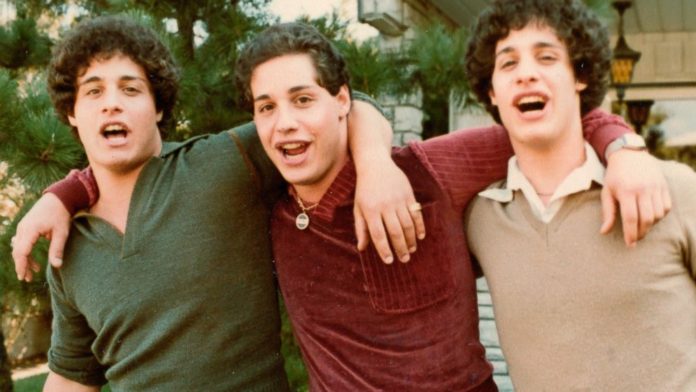The first time that brothers David Kellman, Bobby Shafran and Eddy Galland were in the public eye, it was joyous. The then 19-year-old identical triplets, separated at birth, had just learned about the others’ existence.
Despite growing up separately, the three big-smiling, curly-haired kids smoked the same cigarettes and finished each other’s sentences. They appeared on shows like Phil Donahue, became early ’80s tabloid regulars and even made a cameo alongside Madonna in 1985’s “Desperately Seeking Susan.” They opened a restaurant in New York’s Soho called Triplets Roumanian Steak House.
“We were sort of falling in love,” Kellman recalls in the new documentary “Three Identical Strangers.”
Their second go-around has been more complicated. Galland killed himself in 1995. And the disturbing reasons for their separation only emerged after that initial glow of reunion. “Three Identical Strangers,” directed by British filmmaker Tim Wardle, is the stranger-than-fiction tale behind their story, one of the more disquieting cases of separation at birth.
Since its Sundance Film Festival debut, the film — a real-life roller-coaster ride into a dark and twisted history — has astonished and infuriated moviegoers in equal measures. It has renewed pressure on a prominent child development center to make the study transparent. And it has returned the remaining brothers to the spotlight under far less festive circumstances.
“When we went through the limelight before it was celebratory. It was all fun,” Kellman, now 57, said in an interview. “Is this somewhat enjoyable? Yeah, but it brings up a lot of pain too.
“Seeing it in the theater really got me,” he added. “I cried like a baby.”
“Three Identical Strangers,” which opens in theaters Friday, is about a much-documented case that had largely receded from public memory. After the triplets found each other in 1980 (Shafran, remarkably, arrived at an upstate New York community college only to find everyone already knew him, believing him to be the already-enrolled Galland), another discovery followed.
The triplets, born in 1961, were placed with three families — one upper class, one middle, one working — by the now-defunct Louise Wise Agency as part of a study about nature vs. nurture by the Child Development Center. The center would later merge with the Jewish Board of Family and Children’s Services, a large, 140-year-old New York nonprofit.
The study — which encompassed an unknown number of twins — was conducted through the 1960s and ’70s by Dr. Peter Neubauer, a prominent, Austrian-born psychologist who died in 2008. Without the knowledge of the children or their parents, researchers studied the children’s development right until…










